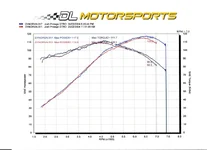Replica said:
When I had my civic, I ran a 4-1 SS header, with NO exhaust. It had a huge 2.5 inch collector that didn't fit on my stock exhaust. Before I would make boost, the car had less torque than stock? Why is that? Because motors need backpressure? Oddly enough, the less backpressure an exhaust has, the less "scavanging" it does too. Also, the less backpressure the less velocity it had too.
It's not backpressure that gives cars with smaller exhaust more torque, it's being able to maintain exhaust velocity at low RPM. At low RPM, there isn't much backpressure in ANY car, since there's not a whole lot of gas being forced out the pipes. But gas IS being forced out nontheless. The same amount of gases have to exit the tailpipe if you have 2" or 2.5" exhaust. They have the same amount of time to do it too, so with 2" exhaust, velocity has to be higher than in the 2.5" piping to get the same amount of gases out. This increased velocity at low RPM is what allows for low RPM scavaging. Faster moving gases will pull more intake charge into the combustion chamber. A well designed 2" exhaust system, with free flowing cat, resonator and muffler made with mandrel bends will lower backpressure over a 2" system with crimped bends, stock cat and resonator and the restrictive muffler. This system, because of it's smoother and more free-flowing insides, will give you less backpressure AS WELL AS more velocity. You will actually increase torque at low RPM even though it has less backpressure. This system will have very high velocity at higher RPM, but at a certain point, it won't be able to flow the VOLUME of air needed to support high RPM power, and you will start to lose power.
2.5" exhaust is extreme for a small 4 cyl engine. With larger piping, at low RPM, you have very little exhaust velocity. This means that it will not scavage very well. Due to the Bernoulli effect, the 2.5" exhaust may even have MORE backpressure than the 2" free flowing exhaust I described(Faster moving air, has less pressure. Slow moving air has more pressure). Low exhaust velocity and higher backpressure means lower power and torque at low RPMs.
As RPMs rise, the extreme free flowing nature of the 2.5" exhaust allows the engine to flow more air and have very little backpressure at high RPM(wheras the restrictions in the 2" exhaust will start to choke the engine), and aid in high RPM scavaging.
With my 2.5" exhaust, I lost 3hp between 2500-3000rpm(but who cares?), maintained peak torque at 4500rpm and gained power up high(above 6000rpm), and got 5hp at 7000rpm. I traded high for low. If I went for 2.25" exhaust, i would have probably gained 2-3hp over the entire rev range, with lower gains down low than I would get up top.
I decided to go with 2.5" exhaust because of the extreme mods I have planned(cams, bored throttle body, head work, intake manifold work etc). With all that work, a 2.25" exhaust would be restrictive at 8000rpm. 2" exhaust just wouldn't be able to flow enough air at that RPM.
recap
small diameter tubing=good velocity at low RPM, high RPM restriction, good low RPM scavaging(ie, better Volumetric efficiency and more torque)
large diameter tubing=poor velocity at low RPm, high velocity and low restriction at high RPM, poor low RPM scavaging, good high RPM scavaging(ie better Volumetric efficency and more power)
sidenote:hp is a factor of torque, mutliplied by RPM. High RPM power, is the same as high RPM torque, and low RPM power is the same thing as low RPM torque
Once again, backpressure is extremely undesirable under EVERY circumstance. It's not backpressure that gets smaller diamter exhaust equipted cars torque...it's VELOCITY.


